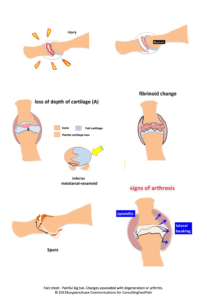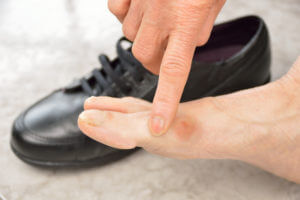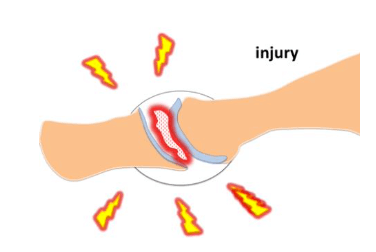The painful ‘big toe’ (hallux) joint explained – hallux limitus
Our task as clinicians is to prevent the worsening of the painful bunion – hallux valgus or stiff toe known as hallux limitus. Long-term failure to act means the joint fails to work. Two main reasons arise: The toe is deformed, forming a bunion or becoming stiff. The stiffness is often called arthritis, but degenerative changes are more likely the reason for pain. Four conditions are considered –
- Spasm due to inflammation (repeated strain)
- Loose body (not necessarily fracture)
- Split or worn cartilage
- An excessive outgrowth of bone (spurs or osteophytes)
This condition may also be associated with hallux valgus, where the great toe is deviated. Hallux Valgus known as bunion.

This book is available from AMAZON books as an eBook or in paperback colour
You can download a PDF version with diagrams

The condition is often time-delayed. This means pain arises later or repeats and forms part of the concept of timeline development. You may be fine now, but later problems peak again. Many of such conditions are highlighted on my website ConsultingFootPain. An event when young (10-25) may not show up until 45-65. Exercise often provokes an existing problem in older age.
Lubrication
 The surface of the bone requires lubrication. The joint oil or synovial fluid makes the process work smoothly. If the fluid increases within the joint, the toe can become painful, or, if it may dry out, causing the surfaces to scrape against each other. This in turn causes impingement which then creates symptoms associated with pain.
The surface of the bone requires lubrication. The joint oil or synovial fluid makes the process work smoothly. If the fluid increases within the joint, the toe can become painful, or, if it may dry out, causing the surfaces to scrape against each other. This in turn causes impingement which then creates symptoms associated with pain.
What causes these stiff toes?
Lack of movement leads to poor lubrication, BUT, if the cartilage is split or damaged, flexibility (hydroelastic property) is lost. This hydroelasticity is the bounce-back ability following compression. Cartilage must be able to deform during joint movement. Once this process disappears, the cartilage leads to the bone being exposed. The joint becomes inflamed, and repair cells (white cells and platelets) create more fluid. Small clot formations fill in gaps but tether down movement further. This is where steroid injections may offer some benefit as they can reverse early scar tissue
Joint protection
 In the early stages, the big toe joint is in a protective mode. The muscles tighten around the joint and go into spasm. All movement is lost at this point. The toe may reverse, improve, or stay like this and worsen. An injection of steroid or anaesthetic can expose this as a spasm. Part of the joint, the sesamoid bone, can also be involved. This ball-bearing-like bone jams on movement and can cause spasms (sesamoiditis).
In the early stages, the big toe joint is in a protective mode. The muscles tighten around the joint and go into spasm. All movement is lost at this point. The toe may reverse, improve, or stay like this and worsen. An injection of steroid or anaesthetic can expose this as a spasm. Part of the joint, the sesamoid bone, can also be involved. This ball-bearing-like bone jams on movement and can cause spasms (sesamoiditis).
Bone spurs
 When a joint is affected by long-standing inflammation, new bone forms; this will cause a spur to arise around the top of the joint and sides. These horn-like projections (osteophytes) jam the joint further. Fluid lubrication stops. The effect of toe joint stiffening affects more than the ankle, knee and hip because each works to provide smooth walking. One joint out of action creates a knock-on effect so that lack of movement can affect the body elsewhere.
When a joint is affected by long-standing inflammation, new bone forms; this will cause a spur to arise around the top of the joint and sides. These horn-like projections (osteophytes) jam the joint further. Fluid lubrication stops. The effect of toe joint stiffening affects more than the ankle, knee and hip because each works to provide smooth walking. One joint out of action creates a knock-on effect so that lack of movement can affect the body elsewhere.
Thanks for reading ‘the stiff big toe joint explained’ by David R Tollafield

Published by Busypencilcase Communications Est. 2015
18 June 2021. Modified August 2024
 David is a retired podiatric surgeon and author
David is a retired podiatric surgeon and author


Recent Comments